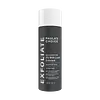Tula Skincare Get Toned Pro-Glycolic 10% Resurfacing Toner Versus Paula's Choice Skin Perfecting 2% BHA Liquid Exfoliant
What's inside
What's inside
 Key Ingredients
Key Ingredients

 Benefits
Benefits

 Concerns
Concerns

 Ingredients Side-by-side
Ingredients Side-by-side

Water
Skin ConditioningGlycolic Acid
BufferingButylene Glycol
HumectantLactococcus Ferment Lysate
Skin ConditioningSodium Hydroxide
BufferingLactic Acid
BufferingSodium Hyaluronate
HumectantAgar
MaskingGlycerin
HumectantTremella Fuciformis Sporocarp Extract
AntioxidantCamellia Sinensis Leaf Extract
AntimicrobialVaccinium Angustifolium Fruit Extract
Skin ProtectingCurcuma Longa Root Extract
MaskingCichorium Intybus Root Extract
MaskingYogurt Extract
Skin ConditioningCarrageenan
Betaine
HumectantGlucose
HumectantLinum Usitatissimum Seed Oil
PerfumingXanthan Gum
EmulsifyingPotassium Sorbate
PreservativeDisodium EDTA
Sodium Chloride
MaskingSodium Benzoate
MaskingPolysorbate 20
EmulsifyingTetrasodium EDTA
Ethylhexylglycerin
Skin ConditioningPhenoxyethanol
PreservativeWater, Glycolic Acid, Butylene Glycol, Lactococcus Ferment Lysate, Sodium Hydroxide, Lactic Acid, Sodium Hyaluronate, Agar, Glycerin, Tremella Fuciformis Sporocarp Extract, Camellia Sinensis Leaf Extract, Vaccinium Angustifolium Fruit Extract, Curcuma Longa Root Extract, Cichorium Intybus Root Extract, Yogurt Extract, Carrageenan, Betaine, Glucose, Linum Usitatissimum Seed Oil, Xanthan Gum, Potassium Sorbate, Disodium EDTA, Sodium Chloride, Sodium Benzoate, Polysorbate 20, Tetrasodium EDTA, Ethylhexylglycerin, Phenoxyethanol
 Reviews
Reviews

Ingredients Explained
These ingredients are found in both products.
Ingredients higher up in an ingredient list are typically present in a larger amount.
Butylene Glycol (or BG) is used within cosmetic products for a few different reasons:
Overall, Butylene Glycol is a safe and well-rounded ingredient that works well with other ingredients.
Though this ingredient works well with most skin types, some people with sensitive skin may experience a reaction such as allergic rashes, closed comedones, or itchiness.
Learn more about Butylene GlycolPolysorbate 20 is made by combining ethoxylation of sorbitan, ethylene oxide, and lauric acid. It is a mild cleansing agent, surfactant, and emulsifier.
As a surfactant, it helps collect dirt and oils for washing. Emulsifiers prevent oils and water from separating.
Polysorbate 20 also adds scent to a product. Since it is made using sorbitol, it has a sweet scent. Sorbitol can also be found in fruits such as apples and peaches.
The lauric acid used to create Polysorbate 20 is often derived from coconuts.
Polysorbate 20 may not be fungal acne safe.
Learn more about Polysorbate 20Sodium Hydroxide is also known as lye or caustic soda. It is used to adjust the pH of products; many ingredients require a specific pH to be effective.
In small amounts, sodium hydroxide is considered safe to use. However, large amounts may cause chemical burns due to its high alkaline.
Your skin has a natural pH and acid mantle. This acid mantle helps prevent harmful bacteria from breaking through. The acid mantle also helps keep your skin hydrated.
"Alkaline" refers to a high pH level. A low pH level would be considered acidic.
Learn more about Sodium HydroxideTetrasodium EDTA is the salt formed from neutralizing ethylenediamine tetraacetic acid with sodium hydroxide. It is a chelating agent and used to prevent metal ions from binding to other ingredients. This helps keep the product and ingredients stable.
Tetrasodium EDTA comes as a white solid and is soluble in water.
Water. It's the most common cosmetic ingredient of all. You'll usually see it at the top of ingredient lists, meaning that it makes up the largest part of the product.
So why is it so popular? Water most often acts as a solvent - this means that it helps dissolve other ingredients into the formulation.
You'll also recognize water as that liquid we all need to stay alive. If you see this, drink a glass of water. Stay hydrated!
Learn more about Water